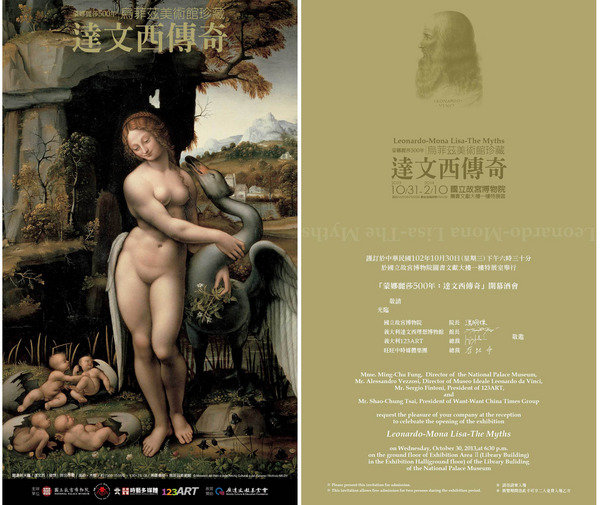Leonardo-Mona Lisa
dal 29/10/2013 al 9/2/2014
Segnalato da
Museo Ideale Leonardo Da Vinci
29/10/2013
Leonardo-Mona Lisa
National Palace Museum, Taipei
The Myths. The exhibition, in twenty-one sections, addresses a key topic in the history of art and culture of our time: Leonardo and the Mona Lisa in the complex mixture of myth and reality, or rather of the universal genius and the most famous painting in the world. It extends from the design of cosmologies to technological design.

Organized on the occasion of the first centenary (1913-2013) of the Mona Lisa recovery after the 1911 theft, this exhibition addresses a key topic in the history of art and culture of our time: Leonardo and the Mona Lisa in the complex mixture of myth and reality, or rather of the universal genius and the most famous painting in the world. It assembles a knot of knowledge of five centuries and an impressive phenomenon: artists of the twentieth century have enriched the topic with interpretations, intellectual provocations and new languages.
The idea of beauty that generates harmony on the human scale has a central role in the culture of Humanism and Renaissance.
This exhibition is presented in a predominantly “female manner,” in relation to the most representative character of the Renaissance, Leonardo da Vinci and his circle, his influences and his fortunes at different times until today. There are significant differences between him and his contemporaries. For example, the originality of Michelangelo in his time and his influences in modern and contemporary times are dazzling. But even more so are those of Leonardo who, with his utopian, tough testing and experimentation, anticipated and changed the making of art “total and complete,” even in relation to science and technology.
The idea of beauty for Leonardo is beyond comparison, complexity and modernity; it leans towards the universal and, at the same time, is composite and recognizable in every detail of his work, even in the smallest informal sketches or stenography. It is not only elegant, but also responds to the utility, analytical and expressive needs.
Leonardo’s idea of beauty is moral and spiritual, inner and outer; it is expressed in the art as a synthesis of art and science, experience of nature and the extreme artifice. It is conceptual and physical, in technique and in style; it is configured according to human and mathematical proportions, physiognomical and psychological all out to the “movements of the soul.”
It extends from the design of cosmologies to technological design. Leonardo investigated it in the similarities between the “body of the earth” and the human body as a machine, painting as a contraption, architecture and the city as living bodies. Leonardo mimicked nature not because he reproduced it, but because of the method by which he created beauty, inventing new forms of expression, in order to reveal its reasons and configure it in the great enigma of art.
With the beauty, which for him was the “need” and “eternal rule,” Leonardo wanted to transform the world around him, and used the pictorial inventions to renew the concept of art, to capture the soul of the world, its dynamics, its mechanics and sublime metaphysics. It was the culmination of an “avant-garde renaissance” four centuries earlier and in a much more comprehensive manner than those of the twentieth century, including the Neo-avant-garde.
Simply put, the twenty-one sections of the exhibition can be summarized in four paths that interact with each other:
First, the exhibition addresses the context of Leonardo and his workshop, a characteristic of the Renaissance, which produced replicas and variants with collaborators and followers.
Then, it moves around the Mona Lisa, veiled and naked, from the beginning of the sixteenth century (with its origins still not completely understood) until the nineteenth century, when the Louvre made it visible and the subject of an aesthetic cult.
Third, it examines the theft of 1911 (which makes it famous and popular on a global level) and its desecration by Duchamp’s Dadaist approach to the present day, in the growing of myth-making, from art to the mass media.
Finally, it highlights the application of science and technology with examples of instruments invented by Leonardo for art and design.
This exhibition outlines an original vision expanded by the phenomenon that best represents the relevance of Leonardo, between the sublime beauty and the “vitality of the negative,” between “codes and contraptions” in “action and poetry.”
Reception on Wednesday, October 30, at 6:30pm
National Palace Museum
Add: No.221, Sec. 2, Zhishan Rd., Shilin Dist., Taipei City 11143, Taiwan (R.O.C.)
Open daily from 08:30 to 18:30 all year round



